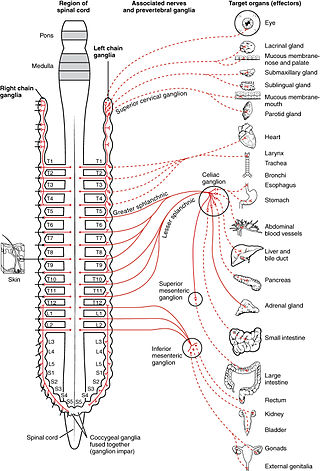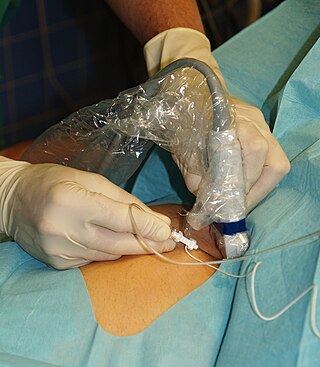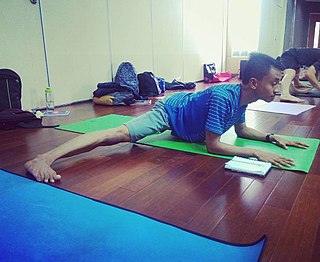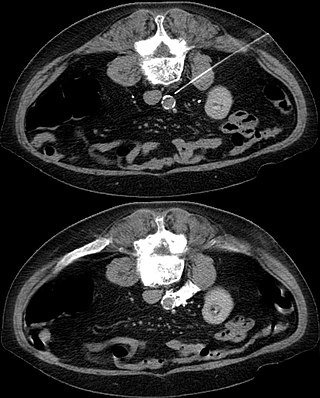Related Research Articles
Local anesthesia is any technique to induce the absence of sensation in a specific part of the body, generally for the aim of inducing local analgesia, i.e. local insensitivity to pain, although other local senses may be affected as well. It allows patients to undergo surgical and dental procedures with reduced pain and distress. In many situations, such as cesarean section, it is safer and therefore superior to general anesthesia.

The sympathetic nervous system (SNS) is one of the three divisions of the autonomic nervous system, the others being the parasympathetic nervous system and the enteric nervous system. The enteric nervous system is sometimes considered part of the autonomic nervous system, and sometimes considered an independent system.

Pain management is an aspect of medicine and health care involving relief of pain in various dimensions, from acute and simple to chronic and challenging. Most physicians and other health professionals provide some pain control in the normal course of their practice, and for the more complex instances of pain, they also call on additional help from a specific medical specialty devoted to pain, which is called pain medicine.
Eye movement desensitization and reprocessing (EMDR) is a form of psychotherapy that is controversial within the psychological community. It was devised by Francine Shapiro in 1987 and originally designed to alleviate the distress associated with traumatic memories such as post-traumatic stress disorder (PTSD).

Leuprorelin, also known as leuprolide, is a manufactured version of a hormone used to treat prostate cancer, breast cancer, endometriosis, uterine fibroids, as part of transgender hormone therapy, for early puberty, or to perform chemical castration of violent sex offenders. It is given by injection into a muscle or under the skin.

The stellate ganglion is a sympathetic ganglion formed by the fusion of the inferior cervical ganglion and the first thoracic ganglion, which is present in 80% of individuals. Sometimes, the second and the third thoracic ganglia are included in this fusion.

The pterygopalatine ganglion is a parasympathetic ganglion in the pterygopalatine fossa. It is one of four parasympathetic ganglia of the head and neck,.

Nerve block or regional nerve blockade is any deliberate interruption of signals traveling along a nerve, often for the purpose of pain relief. Local anesthetic nerve block is a short-term block, usually lasting hours or days, involving the injection of an anesthetic, a corticosteroid, and other agents onto or near a nerve. Neurolytic block, the deliberate temporary degeneration of nerve fibers through the application of chemicals, heat, or freezing, produces a block that may persist for weeks, months, or indefinitely. Neurectomy, the cutting through or removal of a nerve or a section of a nerve, usually produces a permanent block. Because neurectomy of a sensory nerve is often followed, months later, by the emergence of new, more intense pain, sensory nerve neurectomy is rarely performed.

Yoga as therapy is the use of yoga as exercise, consisting mainly of postures called asanas, as a gentle form of exercise and relaxation applied specifically with the intention of improving health. This form of yoga is widely practised in classes, and may involve meditation, imagery, breath work (pranayama) and calming music as well as postural yoga.
Complex post-traumatic stress disorder (CPTSD) is a stress-related mental disorder generally occurring in response to complex traumas, i.e., commonly prolonged or repetitive exposures to a series of traumatic events, within which individuals perceive little or no chance to escape.
Proctalgia fugax, a variant of levator ani syndrome, is a severe, episodic pain in the regions of the rectum and anus. It can be caused by cramping of the levator ani muscle, particularly in the pubococcygeal part.

Pelvic pain is pain in the area of the pelvis. Acute pain is more common than chronic pain. If the pain lasts for more than six months, it is deemed to be chronic pelvic pain. It can affect both the male and female pelvis.
Dark therapy is the practice of keeping people in complete darkness for extended periods of time in an attempt to treat psychological conditions. The human body produces the melatonin hormone, which is responsible for supporting the circadian rhythms. Darkness seems to help keep these circadian rhythms stable.
A sympatholytic (sympathoplegic) drug is a medication that opposes the downstream effects of postganglionic nerve firing in effector organs innervated by the sympathetic nervous system (SNS). They are indicated for various functions; for example, they may be used as antihypertensives. They are also used to treat anxiety, such as generalized anxiety disorder, panic disorder and PTSD. In some cases, such as with guanfacine, they have also shown to be beneficial in the treatment of ADHD.

The lumbar ganglia are paravertebral ganglia located in the inferior portion of the sympathetic trunk. The lumbar portion of the sympathetic trunk typically has 4 lumbar ganglia. The lumbar splanchnic nerves arise from the ganglia here, and contribute sympathetic efferent fibers to the nearby plexuses. The first two lumbar ganglia have both white and gray rami communicates.

Sympathicolysis is a procedure for temporary or long-term elimination of sympathetic innervation. It is used to improve blood circulation in the legs or arms. The sympathetic nervous system causes the balance of the autonomic system to lean towards narrowing of blood vessels, with elimination of its function resulting in vasodilatation. Completely blocked arteries are not opened again, but the collaterals are better supplied with blood.
Interventional pain management or interventional pain medicine is a medical subspecialty defined by the National Uniforms Claims Committee (NUCC) as, " invasive interventions such as the discipline of medicine devoted to the diagnosis and treatment of pain related disorders principally with the application of interventional techniques in managing sub acute, chronic, persistent, and intractable pain, independently or in conjunction with other modalities of treatment". Medicare Payment Advisory Commission (MedPAC) defined interventional techniques as, "minimally invasive procedures including, percutaneous precision needle placement, with placement of drugs in targeted areas or ablation of targeted nerves; and some surgical techniques such as laser or endoscopic diskectomy, intrathecal infusion pumps and spinal cord stimulators, for the diagnosis and management of chronic, persistent or intractable pain". Minimally invasive interventions such as facet joint injections, nerve blocks, neuroaugmentation, vertebroplasty, kyphoplasty, nucleoplasty, endoscopic discectomy, and implantable drug delivery systems are utilized in managing subacute or chronic pain.
PTSD or post-traumatic stress disorder, is a psychiatric disorder characterised by intrusive thoughts and memories, dreams or flashbacks of the event; avoidance of people, places and activities that remind the individual of the event; ongoing negative beliefs about oneself or the world, mood changes and persistent feelings of anger, guilt or fear; alterations in arousal such as increased irritability, angry outbursts, being hypervigilant, or having difficulty with concentration and sleep.
Epigenetics of chronic pain is the study of how epigenetic modifications of genes affect the development and maintenance of chronic pain. Chromatin modifications have been found to affect neural function, such as synaptic plasticity and memory formation, which are important mechanisms of chronic pain. In 2019, 20% of adults dealt with chronic pain. Epigenetics can provide a new perspective on the biological mechanisms and potential treatments of chronic pain.
Brainspotting is a psychotherapy technique that attempts to help people process psychological trauma or other problems via eye movements. Practitioners of this technique use a pointer to direct a client’s eye gaze in order to send signals to the brain to resolve psychological or physical concerns. Brainspotting has not been rigorously studied and has frequently been characterized as a pseudoscience or fringe medicine.
References
- 1 2 3 "BBS Radio". BBS Radio. Retrieved Feb 5, 2019.
- ↑ "'I don't know if it's a miracle, but it's working for me.' Treatment may help with PTSD". The Sacramento Bee. ISSN 0890-5738 . Retrieved 2019-04-30.
- ↑ Kime, Patricia (Nov 19, 2014). "Neck injections a viable treatment for PTSD, researchers say". Military Times. Retrieved Feb 3, 2019.
- ↑ Phillips, Michael M. (June 12, 2017). "Can a Single Injection Conquer PTSD? The Army Wants to Find Out". The Wall Street Journal. Retrieved Feb 3, 2019.
- ↑ "Doctor: PTSD injection can work miracles, but DOD won't fund it". Stars and Stripes. Retrieved 2019-04-30.
- ↑ Olmsted, Kristine L. Rae; Bartoszek, Michael; Mulvaney, Sean; McLean, Brian; Turabi, Ali; Young, Ryan; Kim, Eugene; Vandermaas-Peeler, Russ; Morgan, Jessica Kelley; Constantinescu, Octav; Kane, Shawn (2019-11-06). "Effect of Stellate Ganglion Block Treatment on Posttraumatic Stress Disorder Symptoms: A Randomized Clinical Trial". JAMA Psychiatry. 77 (2): 130–138. doi:10.1001/jamapsychiatry.2019.3474. PMC 6865253 . PMID 31693083.
- 1 2 Chicago, Tribune (Apr 3, 2006). "Lipov Obituary - Chicago, IL". Legacy.com. Retrieved Feb 5, 2019.
- ↑ "Dr. Sergei G Lipov, MD - Reviews". Vitals. Retrieved Feb 3, 2019.
- ↑ Lipov, Eugene. "Eugene G. Lipov, M.D." (PDF). LexVisio. Retrieved Feb 5, 2019.[ dead link ]
- ↑ "House Committee on Veteran's Affairs". Roundtable on Innovative Treatments. Retrieved Feb 3, 2019.
- ↑ Drummond, Katie (July 19, 2010). "Obama Loves This Freaky PTSD Treatment; the Pentagon, Not So Much". Wired. Retrieved Feb 3, 2019.
- ↑ Lipov, Eugene G. (Nov 2013). "Peripheral nerve field stimulation for the management of localized chronic intractable back pain: results from a randomized controlled study". Neuromodulation: Technology at the Neural Interface. 16 (6): 565–575. doi:10.1111/ner.12055. PMID 23577773. S2CID 23807663 – via Google Scholar Citations.
- ↑ Mulvaney, Sean W.; Lynch, James H.; Hickey, Matthew J.; Rahman-Rawlins, Tabassum; Schroeder, Matthew; Kane, Shawn; Lipov, Eugene (2014). "Stellate Ganglion Block Used to Treat Symptoms Associated With Combat-Related Post-Traumatic Stress Disorder: A Case Series of 166 Patients". Military Medicine. 179 (10): 1133–1140. doi: 10.7205/milmed-d-14-00151 . PMID 25269132.
- ↑ Lipov, Eugene G. "University of Illinois at Chicago | UIC · Department of Anesthesiology (Chicago)". Researchgate. Retrieved Feb 3, 2019.
- ↑ Lipov, Eugene. "eugene lipov MD". Google Scholar Citations. Retrieved Feb 3, 2019.
- 1 2 Lipov, Eugene G. (June 2009). "A unifying theory linking the prolonged efficacy of the stellate ganglion block for the treatment of chronic regional pain syndrome (CRPS), hot flashes, and posttraumatic stress disorder (PTSD)". Medical Hypotheses. 72 (6): 657–661. doi:10.1016/j.mehy.2009.01.009. PMID 19237252.
- ↑ Lipov, Eugene (2013). "More evidence supporting unified theory of stellate ganglion block". Medical Hypotheses. 81 (1): 146. doi:10.1016/j.mehy.2013.04.018. PMID 23657137 – via Google Scholar Citations.
- ↑ Lipov, Eugene G. (Feb 1, 2010). "a Randomized Controlled Feasibility Trial to Evaluate Peripheral Nerve Field Stimulation Using Subcutaneous Placement of Neurostimulation Leads in the Treatment of Localized Chronic Intractable Pain of the Back: 146". Pain Medicine. 11: 146 – via Google Scholar Citations.
- ↑ Lipov, Eugene (2011). 'Hybrid neurostimulator': simultaneous use of spinal cord and peripheral nerve field stimulation to treat low back and leg pain. Progress in Neurological Surgery. Vol. 24. pp. 147–155. doi:10.1159/000323047. ISBN 978-3-8055-9489-9. PMID 21422785 – via Google Scholar Citations.
{{cite book}}:|journal=ignored (help) - ↑ Fuller, Ruth (Sep 9, 2009). "Doctor pens children's book about heart health, obesity". The Chicago Tribune. Retrieved Feb 3, 2019.